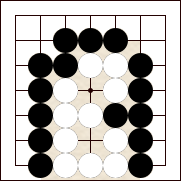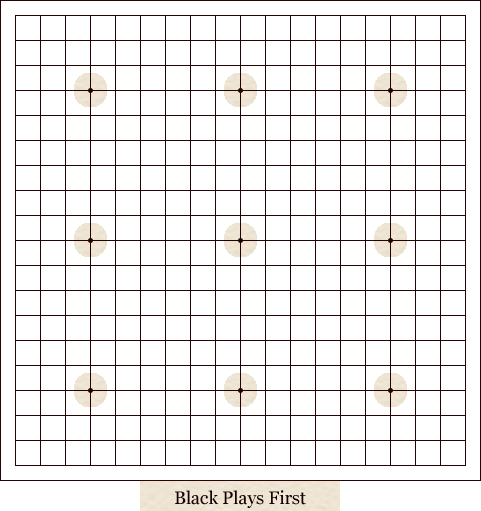|
Because the goal in a game of Go is to surround the most area, good players look for the most efficient moves, that is, moves that offer the maximum gain. Often this involves using the edges of the board as natural borders in helping form territory. Diagrams 1 and 2 below illustrate this idea.
In Diagram 1 six stones surround 9 points in the corner, while in Diagram 2 six stones surround just 2 points in the middle of the board.
Territory is not created by a single move, but by several moves that create a framework of stones. Efficiently placed stones will create a larger area of influence, and potential territory, than inefficient stones. An extreme example is shown in Diagram 3. The three Black stones surround a single point, while the three White stones are poised to control over half the board. |
|
 |
||||||||||||||||||||
 |
|
Note: If you are using an earlier version of Netscape than version 6, you may need to refresh the browser to see the different handicap configurations in this animated diagram.
Congratulations, you have now learned how to play Go! While the rules are quite simple, they lead to a surprising variety of patterns and possibilities, and learning the strategies and tactics of playing well can require much practice and study. At the start perhaps the best way to learn is simply to play a number of games, to become familiar with the patterns, the flow of the game, and how to keep groups alive. At this time don't be too concerned with winning or losing - every champion was once a beginner. One thing you will notice when playing on the larger 19x19 board, compared with the samples on the small 7x7 boards of this introduction, is that several different battles occur during a single game. Even if there is a loss in one corner of the board, the game can be turned around by a success somewhere else. Often there are tradeoffs, where a few stones may be sacrificed in one place in exchange for a profit somewhere else. If you have friends who are also beginners it is helpful to learn together. Even better, if you have some more experienced partners who will play handicap games, you may learn faster from seeing their moves and experimenting how to defend against them. As you learn, you can measure your progress by the fewer number of handicap stones you need. If your town or school has a Go club you can meet new friends who are happy to welcome new players. Also, you now can watch and meet players of all abilities at any time, day or night, from all over the world, on IGS Panda Net, the Internet Go Server. We hope you will come to appreciate and enjoy Go as a game and an art. |
||||||||||||||||||||
|
|
||||||||||||||||||||
| [Let's Play] [Contents - Learning Go] [Introduction] | ||||||||||||||||||||
 |
 |
 |
 |
 |
 |
 |
 |
 |
 |
 |
 |
 |
 |
 |
 |
 |
 |
 |
 |